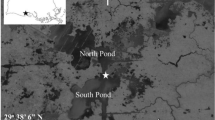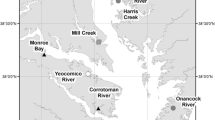Abstract
Increases in relative sea level are fragmenting the emergent vegetation of Louisiana’s coastal marshes. Nekton abundance is likely impacted by salinity and whether emergent vegetation is replaced by submerged aquatic vegetation (SAV) or open water. To assess these effects, we sampled nekton densities along a salinity gradient (categorized as freshwater, intermediate, and brackish marsh) in fragmented and non-fragmented areas. Total nekton density increased strongly with SAV in brackish marsh but only weakly in freshwater marsh (F 2,238 = 10.03, p < 0.0001). Freshwater and intermediate marshes had higher nekton densities when fragmented than when non-fragmented; this relationship was reversed in brackish marsh (F 2,238 = 8.89, p = 0.0002). Fragmentation, SAV, and salinity interacted to affect the densities of Gambusia affinis, Poecilia latipinna, Cyprinodon variegates, and Lucania parva. Our results suggest that the presence of both emergent vegetation and SAV was necessary for maintaining high nekton densities, with this combination being especially important in brackish marshes.







Similar content being viewed by others
References
Baltz, D.M., C. Rakocinski, and J.W. Fleeger. 1993. Microhabitat use by marsh-edge fishes in a Louisiana estuary. Environmental Biology of Fishes 36: 109–126.
Barras, J.A, S. Beville, D. Britsch, S. Hartley, S. Hawes, J. Johnston, P. Kemp, Q. Kinler, A. Martucci, J. Porthouse, D. Reed, K. Roy, S. Sapkota, and J. Suhayda. 2003. Historical and projected coastal Louisiana land changes: 1978–2050: USGS Open File Report 03-334.
Bloomfield, A.L., and B.M. Gillanders. 2006. Fish and invertebrate assemblages in seagrass, mangrove, saltmarsh, and non-vegetated habitats. Estuaries 28: 63–77.
Boesch, D.F., M.N. Josselyn, A.J. Mehta, J.T. Morris, W.K. Nuttle, C.A. Simenstad, and D.J.P. Swift. 1994. Scientific assessment of coastal wetland loss, restoration, and management in Louisiana. Journal of Coastal Research, Special Issue No. 20.
Castellanos, D.L., and L.P. Rozas. 2001. Nekton use of submerged aquatic vegetation, marsh, and shallow unvegetated bottom in the Atchafalya River Delta, a Louisiana tidal freshwater ecosystem. Estuaries 24: 184–197.
Chabreck, R.H. 1970. Marsh zones and vegetative types in the Louisiana coastal marshes. Ph.D. dissertation, Louisiana State University, Baton Rouge, Louisiana.
Chabreck, R.H. 1971. Ponds and lakes of the Louisiana coastal marshes and their value to fish and wildlife. Proceedings of the Annual Conference of the S. E. Association of Game and Fish Commissions 25: 206–215.
Cho, H.J., and M.A. Poirrer. 2005. Response of submersed aquatic vegetation (SAV) in Lake Pontchartrain, Louisiana to the 1997–2001 El Nino Southern Oscillation shifts. Estuaries 28: 215–225.
Connolly, R.M. 1999. Saltmarsh as habitat for fish and nektonic crustaceans: Challenges in sampling designs and methods. Australian Journal of Ecology 24: 422–430.
Crowder, L.B., and W.E. Cooper. 1982. Habitat structural complexity and the interaction between bluegills and their prey. Ecology 63: 1802–1813.
Day, J.W., G.P. Shaffer, L.D. Britsch, D.J. Reed, S.R. Hawes, and D. Cahoon. 2000. Pattern and process of land loss in the Mississippi Delta: A spatial and temporal analysis of wetland habitat change. Estuaries 23: 425–438.
Diehl, S. 1992. Fish predation and benthic community structure: The role of omnivory and habitat complexity. Ecology 73: 1646–1661.
Edmiston, H.L., S.A. Fahrny, M.S. Lamb, L.K. Levi, J.M. Wanat, J.S. Avant, K. Wren, and N.C. Selly. 2008. Tropical storm and hurricane impacts on a Gulf Coast estuary: Appalachicola Bay, Florida. Journal of Coastal Research 55: 38–49.
Frazer, T.K., S.K. Notestein, C.A. Jacoby, C.J. Littlest, S.R. Keller, and R.A. Swett. 2006. Effects of storm-induced salinity changes on submersed aquatic vegetation in Kings Bay, Florida. Estuaries and Coasts 29: 943–953.
Frost, M.T., A.A. Rowden, and M.J. Attrill. 1999. Effect of habitat fragmentation on the macroinvertebrate in faunal communities associated with the seagrass Zostera marina L. Aquatic Conservation: Marine and Freshwater Ecosystems 9: 255–263.
Gornitz, V. 1995. Sea-level rise: A review of recent past and near future trends. Earth Surface Processes and Landforms 20: 7–20.
Hagan, J.M., W.M. Vander Haegen, and P.S. McKinley. 1996. The early development of forest fragmentation effects on birds. Conservation Biology 10: 188–202.
Hovel, K.A. 2003. Habitat fragmentation in marine landscapes: Relative effects of habitat cover and configuration on juvenile crab survival in California and North Carolina seagrass beds. Biological Conservation 110: 401–412.
Hovel, K.A., and R.N. Lipicus. 2001. Habitat fragmentation in a seagrass landscape: Patch size and complexity control blue crab survival. Ecology 82: 1814–1829.
Kanouse, S., M.K. La Peyre, and J. Andrew Nyman. 2006. Nekton use of Ruppia maritima and non-vegetated bottom habitat types within brackish marsh ponds. Marine Ecology Progress Series 327: 61–69.
LCWCRTF. 1999. Coast 2050: Toward a sustainable coastal Louisiana. Louisiana coastal wetlands conservation and restoration task force. Baton Rouge: Lousiana Department of Natural Resources.
Mataraza, L.K., J.B. Terrell, A.B. Munson, and D.E. Canfield Jr. 1999. Changes in submersed macrophytes in relation to tidal storm surges. Journal of Aquatic Plant Management 37: 3–12.
Micheli, F., and C.H. Peterson. 1999. Estuarine vegetated habitats as corridors for predator movements. Conservation Biology 13: 869–881.
Millon, A., J.T. Nielsen, V. Bretagnolle, and A.P. Moller. 2009. Predator–prey relationships in a changing environment: The case of the sparrowhawk and its avian prey community in a rural area. The Journal of Animal Ecology 78: 1086–1095.
Minello, T.J. 1999. Nekton densities in shallow estuarine habitats of Texas and Louisiana and the identification of essential fish habitat. American Fisheries Society Symposium 22: 43–75.
Minello, T.J., R.J. Zimmerman, and R. Medina. 1994. The importance of edge for natant macrofauna in a created salt marsh. Wetlands 14: 184–198.
Minello, T.J., K.W. Able, M.P. Weinstein, and C.G. Hays. 2003. Salt marshes as nurseries for nekton: Testing hypotheses on density, growth and survival through meta-analysis. Marine Ecology Progress Series 246: 39–59.
Morton, R.A., G. Tiling, and N.F. Ferina. 2003. Causes of hot-spot wetland loss in the Mississippi delta plain. Environmental Geosciences 10: 71–80.
Muhlia-Alamazan, A., A. Muhlia-Melo, and G. Alcaraz. 2003. Responses to temperature and salinity by white mullet Mugil curema: Possible explanations for population decrease in Baja California Sur. Marine and Freshwater Behaviour and Physiology 36: 177–185.
Nicholls, R.J., and S.P. Leatherman. 1996. Adapting to sea-level rise: Relative sea-level trends to 2100 for the United States. Coastal Management 24: 301–324.
Nordlie, F.G. 2006. Physiochemical environments and tolerances of cyprinodontoid fishes found in estuaries and salt marshes of eastern North America. Reviews in Fish Biology and Fisheries 16: 51–106.
Penland, S., and K.E. Ramsey. 1990. Relative sea level rise in Louisiana and the Gulf of Mexico: 1908–1988. Journal of Coastal Research 6: 323–342.
Peterson, G.W., and R.E. Turner. 1994. The value of salt marsh edge vs interior as a habitat for fish and decapod crustaceans in a Louisiana tidal marsh. Estuaries 17: 235–262.
Raposa, K.B., and C.A. Oviatt. 2000. The influence of contiguous shoreline type, distance from shore, and vegetation biomass on nekton community structure in eelgrass beds. Estuaries 23: 46–55.
Rathcke, B.J., and E.S. Jules. 1993. Habitat fragmentation and plant–pollinator interactions. Current Science 65: 273–277.
Reyes, E., M.L. White, J.F. Martin, G.P. Kemp, J.W. Day, and V. Aravamuthan. 2000. Landscape modeling of coastal habitat change in the Mississippi delta. Ecology 81: 2331–2349.
Richardson, J.M.L., M.S. Gunzburger, and J. Travis. 2006. Variation in predation pressure as a mechanism underlying differences in numerical abundance between populations of the poeciliid fish Heterandria formosa. Oecologia 147: 596–605.
Robinson, S.K., F.R. Thompson III, T.M. Donovan, D.R. Whitehead, and J. Faborg. 1995. Regional forest fragmentation and the nesting success of migratory birds. Science 267: 1987–1990.
Rozas, L.P., and T.J. Minello. 1997. Estimating densities of small fishes and decapod crustaceans in shallow estuarine habitats: A review of sampling design with focus on gear selection. Estuaries 20: 199–213.
Rozas, L.P., and T.J. Minello. 2006. Nekton use of Vallisneria Americana Michx. (wild celery) beds and adjacent habitats in coastal Louisiana. Estuaries and Coasts 29: 297–310.
Rozas, L.P., and W.E. Odum. 1987. Fish and macrocrustacean use of submerged plant beds in tidal freshwater marsh creeks. Marine Ecology Progress Series 38: 101–106.
Rozas, L.P., and W.E. Odum. 1988. Occupation of submerged aquatic vegetation by fishes: Testing the roles of food and refuge. Oecologia 77: 101–106.
Scavia, D., J.C. Field, D.F. Boesch, R.W. Buddemeier, V. Burkett, D.R. Cayan, M. Fogarty, M.A. Harwell, R.W. Howarth, C. Mason, D.J. Reed, T.C. Royer, A.H. Sallenger, and J.G. Titus. 2002. Climate change impacts on U.S. coastal and marine ecosystems. Estuaries 25: 149–164.
Sheridan, P., and T.J. Minello. 2003. Nekton use of different habitat types in seagrass beds of lower Laguna Madre, Texas. Bulletin of Marine Science 72: 37–61.
Short, F.T., and H.A. Neckles. 1999. The effects of global climate change on seagrasses. Aquatic Botany 63: 169–196.
Short, F.T., and S. Wylie-Echeverra. 1996. Natural and human induced disturbance of seagrasses. Environmental Conservation 23: 17–27.
Skar, F.H., and J.A. Browder. 1998. Coastal environmental impacts brought about by alterations to freshwater flow in the Gulf of Mexico. Environmental Management 22: 547–562.
Sogard, S.M., and K.W. Able. 1991. A comparison of eelgrass, sea lettuce macroalgae, and marsh creeks as habitats for epibenthic fishes and decapods. Estuarine, Coastal and Shelf Science 33: 501–519.
Trombulak, S.C., and C.A. Frissell. 2000. Review of ecological effects of roads on terrestrial and aquatic communities. Conservation Biology 14: 18–30.
Villard, M.A., M.K. Trzinski, and G. Merriam. 1999. Fragmentation effects on forest birds: Relative influence of woodland cover and configuration on landscape occupancy. Conservation Biology 13: 774–783.
Visser, J.M., C.E. Sasser, R.H. Chabreck, and R.G. Linscombe. 1998. Marsh vegetation types of the Mississippi River deltaic plain. Estuaries 21: 818–828.
Wagenius, S., E. Lonsdorf, and C. Neuhauser. 2007. Patch aging and the S-Allee effect: Breeding system effects on the demographic response of plants to habitat fragmentation. The American Naturalist 169: 383–397.
Weaver, J.E., and L.F. Holloway. 1974. Community structure of fishes and macrocrustaceans in ponds of a Louisiana tidal marsh influenced by weirs. Contributions in Marine Science 18: 57–69.
White, G.C., D.R. Anderson, K.P. Burnham, and D.L. Otis. 1982. Capture–recapture and removal methods for sampling closed populations. Los Alamos National Laboratory LA-8787-NERP, 235
Young, A., T. Boyle, and T. Brown. 1996. The population genetic consequences of habitat fragmentation for plants. Trends in Ecology & Evolution 11: 413–418.
Yozzo, D.J., and D.E. Smith. 1998. Composition and abundance of resident marsh-surface nekton: Comparison between tidal freshwater and salt marshes in Virginia, USA. Hydrobiologia 362: 9–19.
Zimmerman, R.J., and T.J. Minello. 1984. Densities of Penaeus aztecus, Penaeus setiferus, and other natant macrofauna in a Texas salt marsh. Estuaries 7: 421–433.
Zimmerman, R.J., T.J. Minello, and G. Zamora Jr. 1983. Selection of vegetated habitat by brown shrimp Penaeus aztecus, in a Galveston Bay salt marsh. Fishery Bulletin 82: 325–336.
Acknowledgements
This research was funded in part by the Louisiana Board of Regents and the United States Environmental Protection Agency’s Science to Achieve Results (STAR) program. Although the research described in this article has been funded in part by the EPA’s STAR program through grant R-82942001 to the Louisiana Board of Regents, it has not been subjected to any EPA review and therefore does not necessarily reflect the views of the Agency and no official endorsement should be inferred. Support was also provided by the Graduate Student Organization of the University of Louisiana at Lafayette. We are grateful to the Center for Ecology and Environmental Technology at the University of Louisiana at Lafayette and R. Holland for use of the airboat and towing vehicle. We gratefully acknowledge Mandalay NWR, P. Yakupzack, B Fortier, Apache Louisiana Minerals, and Burlington Resources for logistical support and access to the marsh. We also thank L. Rozas and R. Twilley for reviews of earlier versions of this manuscript. C. Green provided much assistance in the field.
Author information
Authors and Affiliations
Corresponding author
Rights and permissions
About this article
Cite this article
Hitch, A.T., Purcell, K.M., Martin, S.B. et al. Interactions of Salinity, Marsh Fragmentation and Submerged Aquatic Vegetation on Resident Nekton Assemblages of Coastal Marsh Ponds. Estuaries and Coasts 34, 653–662 (2011). https://doi.org/10.1007/s12237-010-9367-1
Received:
Revised:
Accepted:
Published:
Issue Date:
DOI: https://doi.org/10.1007/s12237-010-9367-1




